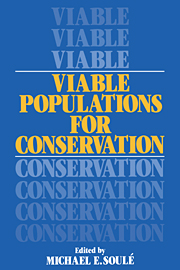Book contents
- Frontmatter
- Contents
- List of contributors
- Preface
- 1 Introduction
- 2 The demography of chance extinction
- 3 Extinction models and mammalian persistence
- 4 Minimum viable population size in the presence of catastrophes
- 5 Minimum viable populations: coping with uncertainty
- 6 Effective population size, genetic variation, and their use in population management
- 7 Spatial structure and population vulnerability
- 8 Managing critically endangered species: the Sumatran rhino as a case study
- 9 The role of interagency cooperation in managing for viable populations
- 10 Where do we go from here?
- Index
3 - Extinction models and mammalian persistence
Published online by Cambridge University Press: 21 January 2010
- Frontmatter
- Contents
- List of contributors
- Preface
- 1 Introduction
- 2 The demography of chance extinction
- 3 Extinction models and mammalian persistence
- 4 Minimum viable population size in the presence of catastrophes
- 5 Minimum viable populations: coping with uncertainty
- 6 Effective population size, genetic variation, and their use in population management
- 7 Spatial structure and population vulnerability
- 8 Managing critically endangered species: the Sumatran rhino as a case study
- 9 The role of interagency cooperation in managing for viable populations
- 10 Where do we go from here?
- Index
Summary
A population, regardless of its size, faces some real probability of becoming extinct by a ‘random walk’ through a series of inopportune events; this idea is not a new one (Goodman, Chapter 2). A number of mathematical models have been constructed to depict this probability of extinction over time. Most of the models have been based upon the intrinsic variation in the reproductive output and deaths of individuals in a species population (MacArthur and Wilson, 1967; MacArthur, 1972; Richter-Dyn and Goel, 1972; Hubbell, 1979; Feller, 1939). The intrinsic variation referred to in the models arises from random changes in birth and death rates and differences in these values that are inherent to individuals (genotypes) composing the population. Solutions to these models demonstrate small probabilities of population extinction for all but very small populations. More recently, it has been demonstrated that populations are much more susceptible to extinction if the environment (Leigh, 1975; 1981; Wright and Hubbell, 1983; Goodman, Chapter 2; Ginzburg et al., 1982; Roughgarden, 1979), including competitors (MacArthur, 1972), contributes to variations in birth and/or death rates.
Another type of extinction model does not rely on variations in birth and death rates. Rather, such models employ a reduction (‘catastrophe’) in population size that occurs at random intervals and perhaps intensities (Strebel, 1985; Hanson and Tuckwell, 1978; Ewens et al., Chapter 4).
- Type
- Chapter
- Information
- Viable Populations for Conservation , pp. 35 - 58Publisher: Cambridge University PressPrint publication year: 1987
- 67
- Cited by



